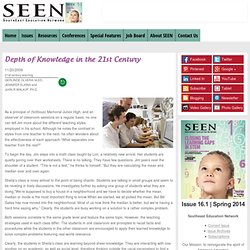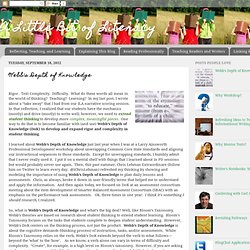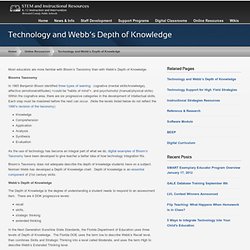

Depth of Knowledge in the 21st Century. To begin the day, Jim steps into a math class taught by Lori, a relatively new arrival.

Her students are quietly poring over their worksheets. There is no talking. They have few questions. Jim peers over the shoulder of a student. “This is not a test,” he thinks to himself. Sheila’s class is noisy almost to the point of being chaotic. Both sessions correlate to the same grade level and feature the same topic. Clearly, the students in Sheila’s class are learning beyond sheer knowledge. As Jim steps out of the classroom, he recalls an email he received from a colleague about 21st century skills. While the “three Rs” are still fundamental to any new workforce entrant’s ability to do the job, employers emphasize that applied skills like teamwork/ collaboration and critical thinking are “very important” to success at work. Rick’s eighth-grade English class looks much like Sheila’s math class, with students arguing over academic content in small formal groups. Teaching 21st Century Skills. Pdfs/ShopTalk PDF/ShopTalk_Spr_09.pdf. Aspire.lacoe.edu/resource/file/resource_68_1352166456.pdf.
Fchsteaching2.wikispaces.com/file/view/1+-+Higher+Order+Thinking+Questions+preso.pdf. Webb's Depth of Knowledge. Rigor.

Text Complexity. Difficulty. What do these words all mean in the world of thinking? Teaching? Learning? I learned about Webb’s Depth of Knowledge just last year when I was at a Larry Ainsworth Professional Development workshop about unwrapping Common Core State Standards and aligning our instructional sequences to those standards. So, what is Webb’s Depth of Knowledge and what’s the big deal? Branching off of a “flipped classroom approach” and because I don’t pretend to be an expert on Webb’s Depth of Knowledge, click here to review (or learn about) the four levels of Webb’s Depth of Knowledge continuum: DoK1. DoK3. DoK4. I believe that each unit needs a mixture, or a balance, of all of the levels above. How do we apply Webb's Depth of Knowledge into our classrooms? If we are asking students to research, for example, here are some ways that we might be able to integrate DoK into a research unit sequentially: DoK1.
DoK2. DoK3. DoK4. How does that look in Writing Workshop? Www.gedtestingservice.com/uploads/files/82e57010694da7e96b811ccb96ecceea.pdf. DOK Question Stems. DOK in Fine Arts. DOK in SS. Depth of Knowledge. DOK Chart. DOK w/ CCSS. Tech and DOK. Most educators are more familiar with Bloom’s Taxonomy than with Webb’s Depth of Knowledge.

Blooms Taxonomy In 1965 Benjamin Bloom identified three types of learning: cognative (mental skills/knowledge), affective (emotional/attitudes) <could be “habits of mind”>, and psychomotor (manual/physical skills) Within the cognative area, there are six progressive categories in the development of intellectual skills. Each step must be mastered before the next can occur. (Note the levels listed below do not reflect the 1990’s revision of the taxonomy) KnowledgeComprehensionApplicationAnalysisSynthesisEvaluation As the use of technology has become an integral part of what we do, digital examples of Bloom’s Taxonomy have been developed to give teacher a better idea of how technology integration fits. Bloom’s Taxonomy does not adequate describe the depth of knowledge students have on a subject.
Webb’s Depth of Knowledge recallskills,strategic thinkingextended thinking. DOK and Bloom's.